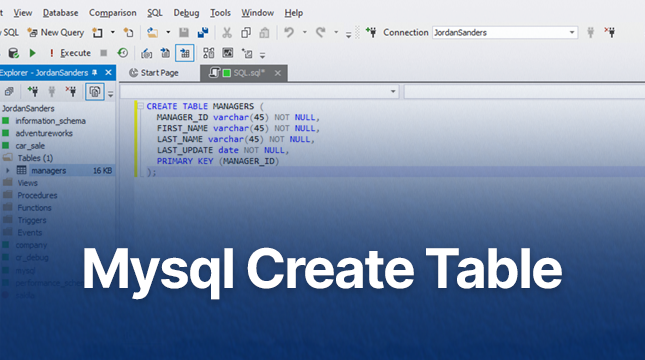This website uses cookies so that we can provide you with the best user experience possible. Cookie information is stored in your browser and performs functions such as recognising you when you return to our website and helping our team to understand which sections of the website you find most interesting and useful.
How to Create Tables in MySQL? A Full Guide for Beginners

In creating a MySQL database, one of the most important things to know is how to create a table in MySQL. However, it is not only about data storage, but also about doing it effectively, safely, and efficiently, and in a manner that can expand. Tables with proper design not only ensure that queries run quicker but also that updates are simple and your database can expand. Using this guide, we will teach you how to create tables in MySQL correctly with tips, examples, and best practices for long-term performance.
Recap of Basic Concepts
It helps to refresh your mind on the basics before moving forward with creating MySQL tables:
Table: They are similar to spreadsheets, and are defined as a group of related information arranged in columns and rows.
Row (Record): An information or a record in the table, such as a single person, a single order, or a single product.
Column (Field): Columns hold specific types of data for each row, like name, age, or email address.
Constraint: Constraints are put on the columns to maintain a neat and clean data appearance and eliminate chances of duplicate records or vacant fields
MySQL-specific things to remember:
- Identifiers: Are the names of databases, tables, and columns. If there is a clash of a name with a MySQL reserved word, it gets wrapped in backticks (`).
- Default Database: MySQL operates in the default database, and thus ensures that you are operating in the correct database before creating tables:
USE database_name;
Syntax & Core Features
One of the initial steps when working with a MySQL database is the creation of a table; however, one must not only know the syntax, but also the purpose of each aspect and the reason why it is so. In simple terms, let us dissect it.
Creating a Table
You use the CREATE TABLE statement to define a new table in your MySQL database. A simple syntax appears like this:
CREATE TABLE table_name (
column1 datatype constraints,
column2 datatype constraints,
...
);
- table_name is the name you give your table, like users or orders.
- Each column defines a type of data you wish to store.
- Datatype will let MySQL know what kind of information should go in that column.
- Constraints are rules that maintain data accuracy and clarity.
When you are clear with this structure, creating a new table is more than typing code; it’s about planning how data lives in your MySQL database.
Most Common Data Types
Every MySQL table has a series of columns, all with a data type that defines what type of information it stores. Choosing the correct data type is mandatory for performance.
INT: Stores whole numbers. INT is suitable for storing data about Ideal for IDs, counts, or any numeric value that doesn’t need decimals.
VARCHAR(size): Stores variable-length strings, such as names, emails, or titles. Size defines the maximum character limit for columns.
TEXT: TEXT is used for large text entries, such as blogs or comment sections. Compared to VARCHAR, it’s capable of holding much more text.
DATE: Storage of dates is possible using the YYYY-MM-DD format, which is perfect for birthdays, order dates, or registration dates.
TIMESTAMP: Stores date and time simultaneously, which is useful for tracking the creation or updating of a record.
BOOLEAN: Will hold true/false values, used for flags such as is_active or is_admin.
Seldom choosing the appropriate data type will ensure your MySQL database is faster, consumes less storage, and lessens future errors.
Constraints
Rules are known as constraints that you put on the columns to ensure that your database is in a good state and is reliable. Consider them as protection of your information.
NOT NULL: This ensures a column cannot be left empty. Each user must have a username, so that column should never be null.
AUTO_INCREMENT: Automatically generates a number for each new record, commonly used for IDs. It saves your time as manually entering these values is eliminated.
DEFAULT: This provides a default value if no other value is available. For instance, you could set a user’s status to active by default when a new account is created.
Using the appropriate constraints will ensure that your MySQL database remains clean, eliminates errors, and simplifies future queries of your data.
Example Table: Users
Here’s a simple example of a users table in a MySQL database:
CREATE TABLE users (
id INT AUTO_INCREMENT,
username VARCHAR(50) NOT NULL,
email VARCHAR(100),
created_at TIMESTAMP DEFAULT CURRENT_TIMESTAMP,
PRIMARY KEY (id)
);
- Id: A unique identifier for each user. INT AUTO_INCREMENT allows users to automatically receive a new unassigned number.
- Username: A required field (NOT NULL) because each individual user needs a username.
- email: Optional, but stored as a VARCHAR(100) to hold email addresses.
- created_at: Tracks when the record was created. The DEFAULT CURRENT_TIMESTAMP makes it automatic.
- PRIMARY KEY (id): Ensures that each user can be uniquely identified in the database.
This is a simple table format, but it shows how a well-structured MySQL database table can organize data, impose restrictions, and provide the basis of scalable and reliable applications.
Constraints & Keys
In the case of a MySQL database, constraints and keys can prove to be very useful in ensuring your data is precise, consistent, and credible. Think of them as rules and relationships that guide how data behaves inside your tables.
Types of Constraints
Constraints are the rules that you impose on the columns of the tables in an attempt to enforce data integrity. In their absence, it is easy to find your database filled with duplicate, lost, or inconsistent information. Let’s look at the constraints by going through the important types:
1. Primary Key
A primary key is a column (or a set of columns) that specifically identifies each record in a table.
- A table must have only one primary key at a time.
- Note that a primary key’s value can never be NULL.
- They ensure that each row is uniquely distinguishable, which is essential for managing and linking data across a database.
Example: In a users table, the id column is typically the primary key because it uniquely identifies each user.
PRIMARY KEY (id)
This guarantees that no two users will ever get identical IDs.
2. Unique
The unique constraint ensures that values in a column are unique.
- A table can have multiple unique constraints at a time.
- It aids in email address or username fields, where duplication is problematic.
Example:
username VARCHAR(50) UNIQUE
Here, no two users can possess identical usernames in your MySQL database.
3. Foreign Key
The foreign key is the one column in a table that links to the primary key in another table.
- This key imposes referential integrity by solidifying relationships between tables.
- They avoid cases of “orphaned” data by allowing values from one table to correspond to valid entries in another table.
Example:
FOREIGN KEY (customer_id)
REFERENCES users(id)
Here, the customer_id in the orders table must match a valid id in the users table. It keeps your MySQL database true because orders cannot exist without customers.
4. Check
A check constraint checks that the values in columns meet a set of conditions.
- Available in MySQL 8.0 and above.
- This supports business rules in your database, eliminating errors.
Example:
CHECK (quantity > 0)
This ensures that you can never insert an order with a negative quantity.
Example Table: Orders with Foreign Key
To get an idea of how they all come together in a real table:
CREATE TABLE orders (
order_id INT AUTO_INCREMENT,
order_date DATE,
customer_id INT,
PRIMARY KEY (order_id),
FOREIGN KEY (customer_id)
REFERENCES users(id)
);
- order_id: Uniquely identifies each order using PRIMARY KEY and AUTO_INCREMENT.
- order_date: It collects and notes the date of order creation.
- customer_id: Links each order to a valid user in the users table using a FOREIGN KEY.
The table shows the use of constraints and keys in a MySQL database to ensure data accuracy and link tables together. With their proper usage, you end up with not only a functional, but also robust, reliable, and scaled-down database.
Advanced Table Features
After knowing the fundamentals of making a table with a MySQL database, it is time to learn some of the advanced features that will allow you to make your tables stronger, effective, and malleable. These traits allow you to work with complex computations, huge data, and multi-language data, not to mention that your database is reliable.
1. Generated Columns
These specially generated columns have their values automatically calculated using other columns in the table.
- These reduce time wastage and errors by substituting manual calculations each time you input or update data.
- As the creator, you will decide whether the column is stored (saved on disk) or virtual (calculated on the spot).
Example: Invoices Table
CREATE TABLE invoices (
subtotal DECIMAL(10,2),
tax_rate DECIMAL(3,2),
total DECIMAL(10,2)
GENERATED ALWAYS AS (subtotal * (1 + tax_rate))
STORED
);
- Subtotal: The base invoice amount.
- tax_rate: The taxation percentage that applies to the amount.
- total: Automatically calculated as subtotal * (1 + tax_rate) every time a row is inserted or updated.
This feature makes your MySQL database smarter and reduces the chance of human error in repetitive calculations.
2. Partitioning
This action divides a large table into smaller, more manageable pieces known as partitions.
Partitions act as miniature tables and are part of the same logical table
They improve query performance, particularly for tables with millions of rows.
It can also make maintenance tasks, like archiving old data, easier.
Indicatively, an orders table can be partitioned based on year or region, i.e., when a query involves recent orders, only a limited portion of the table is scanned rather than the whole data.
Segmentation is another great option to scale your MySQL database in case you are sure that it is going to expand massively in the future.
3. Storage Engines
By default, MySQL will support various storage engines. Storage engine selection decides how to store, access, and manage data. The two most common engines are:
- InnoDB:
- Transaction-safe (supports COMMIT and ROLLBACK).
- Supports foreign keys and constraints for maintaining relational integrity.
- Suit applications that prioritize data consistency above anything else.
- MyISAM:
- Faster for read-heavy operations.
- Lacks transaction and foreign key support.
- Good for analytics or reporting databases where inserts and updates are minimal.
Choosing the right storage engine is crucial for balancing performance, reliability, and data integrity in your MySQL database.
4. Character Sets & Collation
A Character set defines the types of characters that any one column can store. Collation decides how each of these characters will be compared and sorted.
- They are critical to deliver multi-language support.
- ORDER BY and WHERE functions perform as you need with text due to the character set and collation.
Example:
CREATE TABLE messages (
message_id INT AUTO_INCREMENT PRIMARY KEY,
content VARCHAR(500)
CHARACTER SET utf8mb4
COLLATE utf8mb4_general_ci
);
Here, utf8mb4 facilitates emoji and character storage from multiple languages, while utf8mb4_general_ci handles case-insensitive comparisons.
By setting the correct character set and collation, you make your MySQL database ready for global applications and avoid encoding issues.
Indexing & Query Performance in MySQL
In a typical MySQL database, indexes perform the function of a shortcut to find the data you need immediately. Instead of going through the entire table, a MySQL index jumps directly to the spot containing the data you need.
Primary Key Index: Automatically created when you define a primary key.
Unique Index: This function ensures duplicates cannot exist (like two users with identical email addresses).
Composite Index: It merges columns to accelerate data searches.
Note: too many indexes can slow down inserts and updates, and they hold extra disk space.
Example: Composite Index on username and email
CREATE INDEX idx_username_email
ON users(username, email);
Best Practices for MySQL Table Design
When designing tables in your MySQL database, good practices can save you from errors later. See this brief checklist to follow:
- Use the right data types: Always pick the smallest data type that fits your needs. For example, use TINYINT instead of INT if values are small. This keeps storage efficient.
- Define primary keys: Every table should have a primary key, which uniquely identifies each row and improves indexing and performance.
- Set up foreign keys: Leveraging foreign keys to maintain relationships between tables (like users and orders) will uphold data integrity without manual intervention.
- Normalize your data: Break data into separate tables to avoid duplication and keep your database clean and consistent.
- Back up regularly: Databases can fail; always have a backup strategy to prevent data loss.
- Monitor the queries and indexes: Assess your query performance. Add indexes if necessary, but note that using too many can hinder the process.
FAqs
1. What is the difference between a primary key and a unique key in MySQL?
A primary key uniquely identifies each row in a table, and only one can exist per table.
A unique key also enforces uniqueness, but multiple unique keys can exist in a table.
2. Why are foreign keys important in MySQL?
Foreign keys establish relationships between tables. For example, linking orders to users ensures that every order belongs to a valid user, maintaining data integrity.
3. How often should I back up a MySQL database?
It depends on your usage. For critical systems, take daily backups (or even real-time replication). For smaller projects, weekly backups may suffice.
4. What are the most common mistakes when creating tables in MySQL?
- Using incorrect data types (e.g., TEXT for short strings).
- Forgetting to define a primary key.
- Not indexing columns used in searches.
- Ignoring regular backups.

Let's Start Your Project
Get free consultation for your digital product idea to turn it into reality!
Get Started






